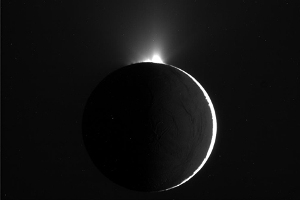Aug 1 2013
Enceladus, a peculiarly small, geologically active moon of Saturn, emits an impressive plume of water vapor and ice from its southern pole, a bit like Yellowstone’s Old Faithful. The Cassini-Huygens spacecraft, circling Saturn since 2004, has the pictures to prove it.
 Cassini's camera took this image in November 2009 of Enceladus, which shows its plume spewing from the south pole region. NASA/JPL/Space Science Institute
Cassini's camera took this image in November 2009 of Enceladus, which shows its plume spewing from the south pole region. NASA/JPL/Space Science Institute
Using Cassini data, Cornell astronomers have determined that the amount of this material erupting from Enceladus depends on tidal forces from Saturn – the same phenomenon that creates tides on Earth.
The research was reported online in the journal Nature July 31, with first author Matthew Hedman, research associate in astronomy, who works with Philip Nicholson, professor of astronomy. Co-authors include members of the Cassini spectrometer team and Mark Showalter, M.S. ’83, Ph.D. ’85, of the SETI Institute.
Since Cassini first took pictures of Enceladus’ plume several years ago, theorists had predicted that the squeezing and squashing of the moon from tidal pressures would pull and push on the cracks on Enceladus’ surface, allowing the plume to break through at varying intensities depending on its orbital position. Using Cassini’s Visual and Infrared Mapping Spectrometer (VIMS), the Cornell researchers offer observational evidence to support that theory.
Low-resolution infrared images taken of the plume at different points in Enceladus’ orbit support the tidal forces theory, Hedman said. When Enceladus was at the farthest point in its orbit from Saturn, the plume was brightest, and when closest, the plume was its dimmest; the amount of plume coming up through the surface cracks was changing systematically as the moon went on its orbit.
“We still don’t know if the tidal forces are powering the plume, but they are definitely affecting how much material escapes from the moon,” Hedman said.
The fact that Enceladus is a relatively small moon and unusual because of its geological activity makes astronomers want to know more about it, Hedman said.
“Enceladus is a very odd little moon,” he said. “No other moon in the Saturn system is nearly so active, and Cassini is giving us the information we need to figure out why that is.”
The study, “An Observed Correlation Between Enceladus Plume Activity and Tidal Stresses,” was supported by NASA. The Cassini-Huygens mission is a project of NASA, the European Space Agency and ASI, the Italian Space Agency.